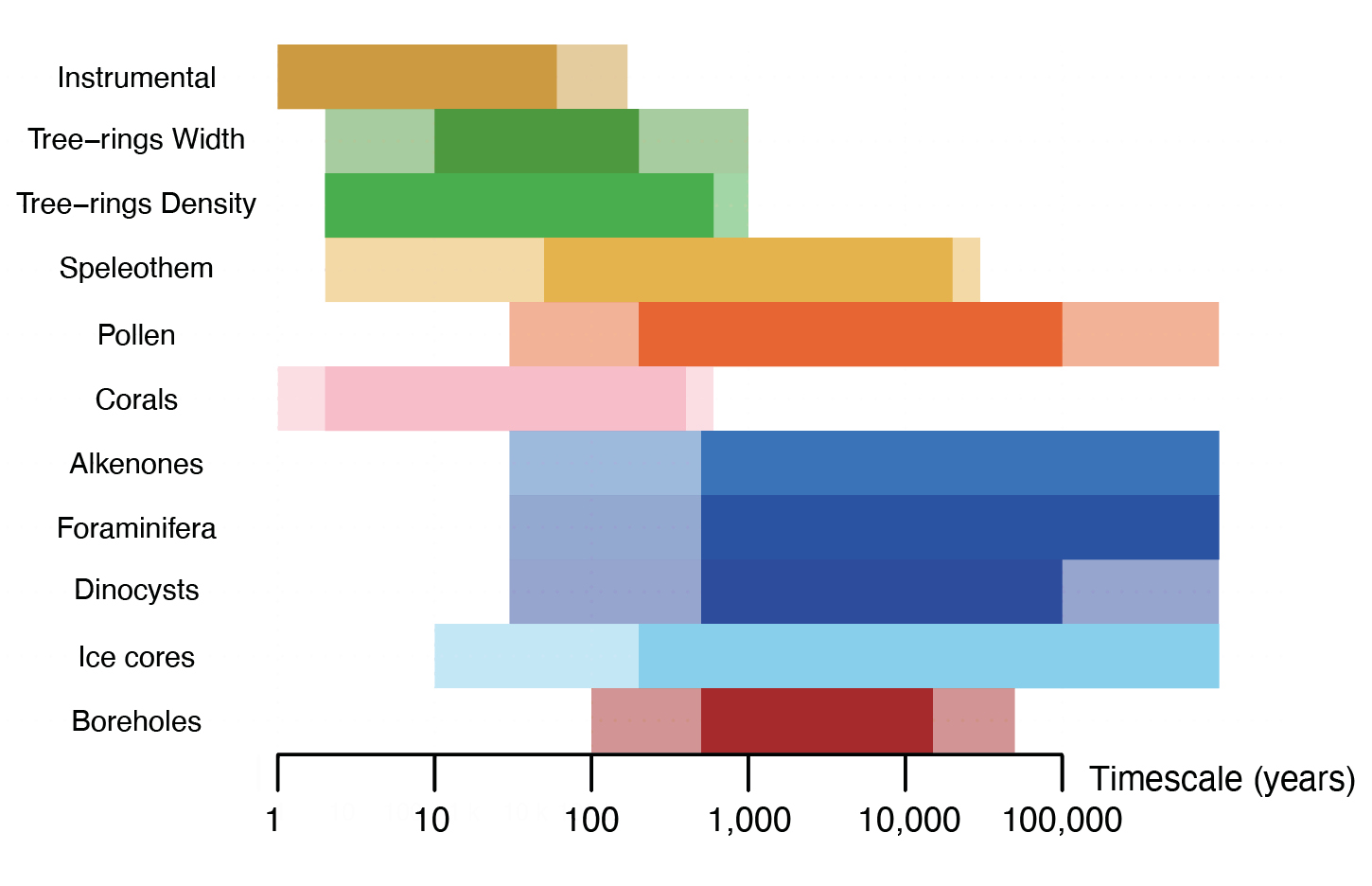- Home
- Publications
- PAGES Magazine
- Climate Variability Across Scales (CVAS): Phase Two
Climate Variability Across Scales (CVAS): Phase Two
Hébert R, Casado M & Laepple T
Past Global Changes Magazine
28(2)
61
2020
Raphaël Hébert, M. Casado and T. Laepple
Climate variability occurs at all timescales, encompassing periodic oscillations such as daily and annual cycles at short timescales and the Milankovitch periodicities at longer timescales, as well as the scaling continuum of climate variability which contains continuously increasing variance with timescale. The climatic signal of the recent instrumental period, when direct measurements are available, contains both natural and anthropogenic signatures. This makes attribution and detection of climate change complicated, particularly at the regional scale where forced variability plays a relatively smaller role.
To demodulate the internal variability from the response to external forcing, which is necessary to improve future climate projections, it is thus needed to go beyond the instrumental record. For instance, it remains uncertain whether the internal variability is dependent on the background state, and thus whether we should expect a warmer world to be more stable, or more variable with increasing occurrence and magnitude of extreme events.
In this context, paleoclimate records are a unique tool to extend our observation of climate variability to longer timescales, to be able to study not only the climate system without the impacts of human activity, but also different background states characterized by various combinations of orbital parameters, greenhouse gas concentrations, climatic conditions, and geological configurations.
Challenges remain, however, in the interpretation of paleoclimate proxies, as many archival processes are involved, each of which may affect the recorded signal. For instance, precipitation intermittency creates aliasing in ice-core records, and then diffusion acts as a low-pass filter (Casado et al. 2020). Similarly, aliasing is created in sediment cores by seasonality and the sampling scheme, while bioturbation and sediment mixing also act as low-pass filters (Dolman et al. 2020). Those non-climatic processes lead to timescale-dependent biases and errors (Kunz et al. 2020) which may completely dominate the climatic signal over particular timescale bands (Fig. 1).
Proxy system modeling (PSM) is crucial in order to recognize and quantify proxy-specific biases, and allow for a formal characterization and interpretation of the transfer function from the climate input to the recorded signal. The further development of PSM is thus an important topic of paleoclimate research and at the heart of CVAS' (pastglobalchanges.org/cvas) research goals, building on the legacy and integrating the former Paleoclimate Reanalyses, Data Assimilation and Proxy System modeling (DAPS; pastglobalchanges.org/daps) group.
Another important aspect of the second phase of CVAS is the development and improvement of statistical tools for the analysis of timeseries and spatial distributions. These will be made available to other PAGES working groups to further space-time analysis in the broader geoscience community.
Both the PSM and statistical tools developed will contribute essential elements to the overarching aim of CVAS: a comprehensive synthesis of the spatio-temporal structure of climate variability, or "the CLIMAP of temperature variability". This implies a particular focus on decadal- to millennial-scale variability, where the greatest knowledge gap lies. Beyond the rather complete picture provided by instrumental data up to decadal timescales, the very long timescales (>10 kyr) are also relatively well quantified since there are few effective spatial degrees of freedom remaining, i.e. a few high-quality timeseries effectively represent the global behavior. The PAGES 2k Network (pastglobalchanges.org/2k) and Speleothem Isotopes Synthesis and AnaLysis (SISAL; pastglobalchanges.org/sisal) working groups will therefore provide very valuable information, which will be at the core of our investigation.
CVAS will subsequently explore the implications of the results for future reconstruction and assimilation efforts, and also for constraining future climate evolution. While climate models have demonstrated their ability to produce realistic forced climate variability, important modeling challenges remain to accurately capture internal feedbacks and processes necessary to close the variance gap with regional climate reconstructions at longer than multidecadal scales (Laepple and Huybers 2014).
The environment, biodiversity, and human society are all linked to the stability of the Earth system and its sensitivity to external forcing, as well as the statistics of extremes. These are thus central topics in PAGES' holistic Earth system science approach, and CVAS has accordingly adopted an interdisciplinary approach based on statistical and spectral analysis. The application of CVAS concepts beyond climate variability will also be explored. Particularly through potential collaboration with the Resistance, Recovery and Resilience in Long-term Ecological Systems (EcoRe3; pastglobalchanges.org/ecore3) and PalEOclimate and the PeopLing of the Earth (PEOPLE 3000; pastglobalchanges.org/people3000) groups, we will investigate possible linkages and interactions between physics and life on timescales longer than centuries.
affiliation
Alfred-Wegener-Institut for Polar and Marine Research, Potsdam, Germany
contact
Raphaël Hébert: raphael.hebert awi.de
awi.de
references
Casado M et al. (2020) Clim Past 16: 1581-1598
Dolman A et al. (2020) Clim Past Discuss, doi:10.5194/cp-2019-153

